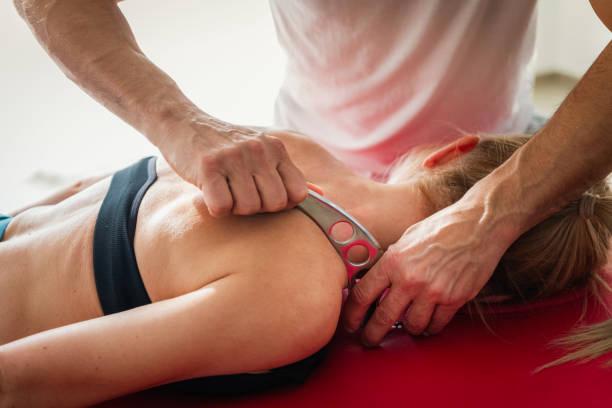IASTM Therapy
Instrument Assisted Soft Tissue Mobilization (IASTM) is an advanced manual therapy technique that uses specialized tools to effectively treat soft tissue injuries and restrictions. Our skilled physiotherapist uses these precision instruments to detect and treat scar tissue, adhesions, and fascial restrictions, promoting faster healing and improved function.


What is IASTM?
Instrument Assisted Soft Tissue Mobilization (IASTM) is a specialized manual therapy technique that uses ergonomically designed instruments to effectively detect and treat soft tissue dysfunction. These precision instruments are used to scan and treat areas of soft tissue fibrosis, chronic inflammation, or degeneration, allowing the physiotherapist to identify areas of restriction and adhesion that might not be detectable using their hands alone.
The treatment works by applying controlled microtrauma to affected soft tissues. This controlled irritation triggers the body's natural inflammatory response, which then initiates the healing process. By breaking down scar tissue and fascial restrictions, IASTM helps restore optimal tissue texture, function, and range of motion. The instruments also help improve blood flow to the area, which accelerates the healing process.
IASTM is particularly effective for conditions that involve soft tissue dysfunction such as tendinopathies, muscle strains, ligament sprains, and fascial restrictions. It's commonly used to treat conditions like IT band syndrome, plantar fasciitis, tennis/golfer's elbow, rotator cuff injuries, and post-surgical scarring. The therapy is typically part of a comprehensive treatment approach that includes therapeutic exercise, stretching, and functional retraining to achieve optimal outcomes.
Benefits of IASTM
Discover how our specialized IASTM treatments can improve your soft tissue health and function
Effective scar tissue breakdown
Increased blood flow to treated areas
Enhanced soft tissue healing
Improved range of motion
Reduced muscle tension and pain
Faster recovery from injuries
Non-invasive treatment option
Our IASTM Techniques
Advanced approaches we use for effective soft tissue treatment and rehabilitation
Graston Technique®
ASTYM®
RockBlades
HawkGrips
Fascial abrasion technique
Cross-fiber treatment
Scanning strokes
Targeted instrument selection for specific tissues
Our Treatment Process
What to expect during your IASTM therapy journey with us
Comprehensive Assessment
Detailed evaluation of your soft tissue condition, movement patterns, and treatment goals.
Treatment Planning
Development of a targeted IASTM protocol specific to your soft tissue restrictions.
Precise Application
Skilled use of specialized instruments to address specific tissue restrictions and promote healing.
Functional Integration
Combining IASTM with movement and exercises to optimize tissue recovery and function.
Conditions We Treat
Our IASTM therapy addresses a wide range of soft tissue conditions and injuries
Tendinopathies (Achilles, Patellar)
IT Band Syndrome
Plantar Fasciitis
Tennis/Golfer's Elbow
Rotator Cuff Injuries
Carpal Tunnel Syndrome
Scar Tissue & Adhesions
Muscle Strains & Tears
Chronic Soft Tissue Inflammation
Frequently Asked Questions
Find answers to common questions about our IASTM therapy service
Is IASTM painful?
IASTM can cause some discomfort during treatment, often described as a scraping or pressure sensation. The level of discomfort varies depending on the area being treated and the condition's severity. Our physiotherapist adjusts the pressure based on your tolerance and the tissue's response. While some discomfort is normal, the treatment should never be excessively painful.
Will I have bruising after treatment?
Light bruising or redness (petechiae) is common after IASTM treatment and is actually a sign that the treatment is working by increasing blood flow to the area. These marks typically fade within a few days. The intensity of marking depends on several factors including your skin sensitivity, the pressure applied, and the condition being treated. We always aim to minimize excessive bruising while ensuring effective treatment.
How many IASTM sessions will I need?
Most patients see benefits within 3-6 sessions, though this varies based on your specific condition and how long you've had it. Acute injuries may respond more quickly, while chronic conditions typically require more sessions. After your initial assessment, our physiotherapist will develop a personalized treatment plan and provide an estimated timeline for your specific case.
What should I do after an IASTM session?
After treatment, we recommend light activity rather than complete rest to enhance the healing process. Staying hydrated is important to help flush metabolic waste released during treatment. Applying ice may help if you experience soreness. We'll provide specific post-treatment instructions tailored to your condition, which may include gentle stretches or exercises to maximize the benefits of your treatment.
Can IASTM be combined with other treatments?
Yes, IASTM works excellently as part of a comprehensive treatment approach. We often combine it with therapeutic exercises, stretching, joint mobilization, and other manual therapy techniques. This integrated approach allows us to address your condition from multiple angles, often leading to faster and more effective outcomes than any single treatment method alone.